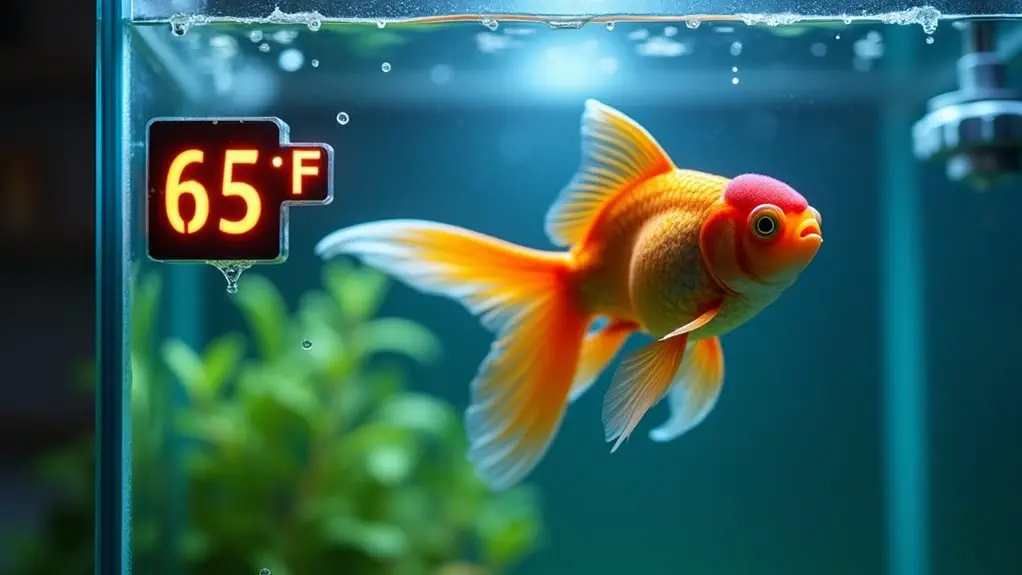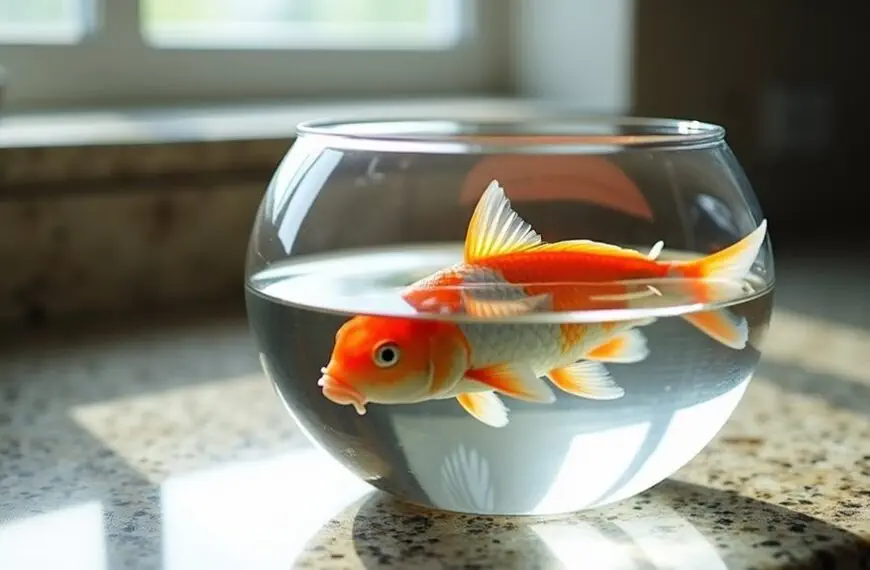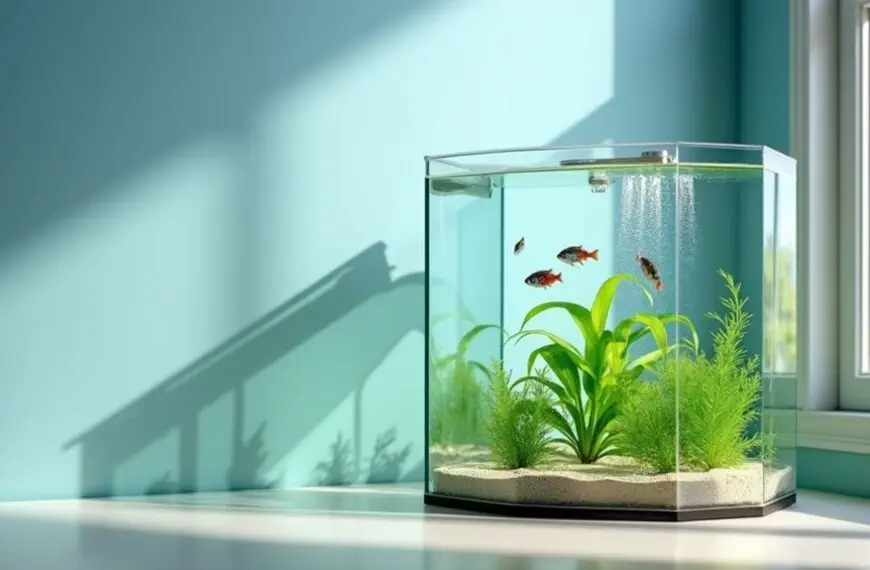While goldfish can survive without a heater, you'll likely want one to keep your finned friends healthy and comfortable. Different breeds have varying temperature needs – fancy goldfish prefer warmer water (72-78°F), while common goldfish do well in cooler conditions (60-70°F). Your tank's location and size play significant roles in temperature stability, and sudden fluctuations can stress your fish, leading to health issues. A quality heater helps maintain consistent temperatures year-round, especially during seasonal changes. For ideal goldfish care, you'll want to understand how temperature management affects everything from their appetite to their immune system.
Contents
- 1 Understanding Goldfish Temperature Requirements
- 2 Different Breeds, Different Needs
- 3 Signs of Temperature Stress
- 4 Tank Location Matters
- 5 Choosing the Right Heater
- 6 Water Quality and Temperature
- 7 Summer and Winter Care
- 8 Heater Installation Tips
- 9 Temperature Monitoring Best Practices
- 10 Frequently Asked Questions
- 10.1 Can Goldfish Survive a Temporary Power Outage Affecting the Heater?
- 10.2 Should Heaters Be Removed During Medication Treatments?
- 10.3 Do Goldfish Need Heaters When Breeding or Spawning?
- 10.4 Can Multiple Heaters Be Used in One Tank?
- 10.5 How Long Do Aquarium Heaters Typically Last Before Needing Replacement?
- 11 Final Thoughts
Understanding Goldfish Temperature Requirements
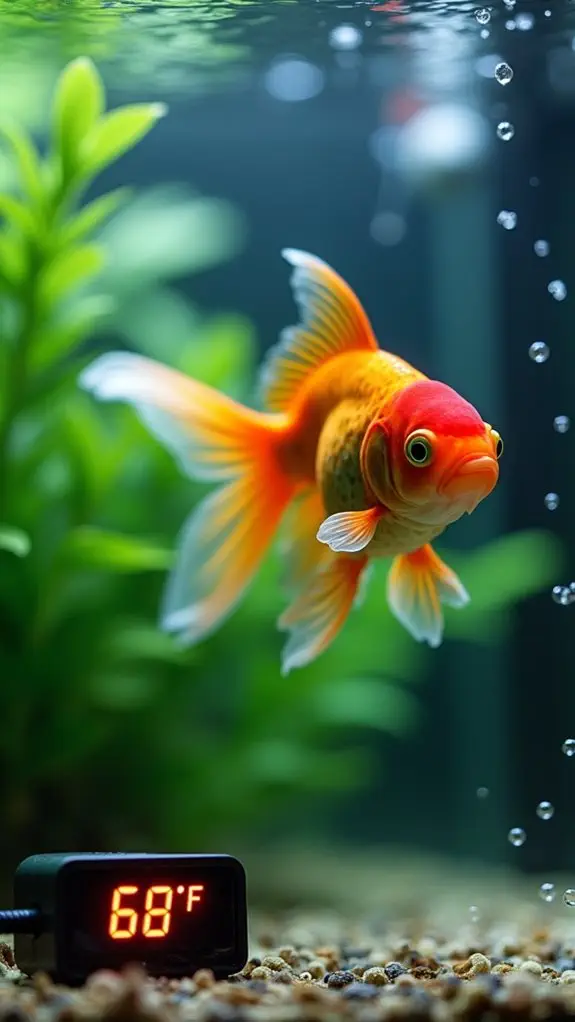
Most goldfish owners don't realize how greatly water temperature affects their pet's well-being. Your goldfish's entire body function depends on the surrounding water temperature, from how quickly they digest food to how efficiently they breathe.
Think of it like your morning coffee – when it's at the right temperature, everything works perfectly! Warmer water reduces the solubility of dissolved oxygen, which is crucial for your goldfish's health, making it vital to monitor temperature closely.
You'll want to pay attention to temperature fluctuations, as they can seriously impact your finned friend's health. The metabolic effects of water temperature are quite remarkable: in warmer water, your goldfish will eat more frequently and process food faster, but they'll also need to work harder to get enough oxygen. In fact, evaporative cooling methods may be necessary during extreme heat conditions. Fish in warmer waters of about 75°F will consume up to tenfold the amount of food compared to those in cooler 58°F waters.
While fancy goldfish prefer temperatures between 70°F and 76°F, common goldfish are happiest in slightly cooler water, around 68°F to 72°F.
Keep in mind that warmer isn't always better – temperatures above 75°F can stress your goldfish and potentially lead to health issues. The sweet spot for long-term health is actually below 70°F, and you'll want to maintain consistent temperatures rather than letting them bounce around like a yo-yo.
Your goldfish will thank you with happy wiggles and healthy growth!
Different Breeds, Different Needs
When choosing a goldfish, it's important to understand that different breeds have distinct temperature requirements.
You'll find that hardy breeds like commons and shubunkins are the tough guys of the goldfish world, happily swimming in temperatures between 60-70°F without breaking a sweat (if fish could sweat, that is!). Stable temperatures within this range are crucial to ensuring their health and well-being.
Your fancy breeds, however, are a bit more particular about their comfort. These elegant swimmers can benefit from higher immune response when kept at their ideal temperatures. These elegant swimmers, including fantails and orandas, prefer their water on the warmer side at 72-78°F. Think of them as the sophisticated cousins who won't step outside without their perfect environment!
When it comes to breed compatibility, you'll need to take temperature extremes carefully into account. Consistent temperatures throughout the year help maintain optimal fish health.
Mixing different types in the same tank requires some thoughtful planning. While hardy breeds can tolerate warmer temperatures, your fancy and tropical varieties absolutely won't appreciate a chilly dip.
If you're planning a mixed community, you'll want to aim for a middle ground that keeps everyone comfortable – just like finding the perfect thermostat setting for a house full of people with different preferences!
Signs of Temperature Stress
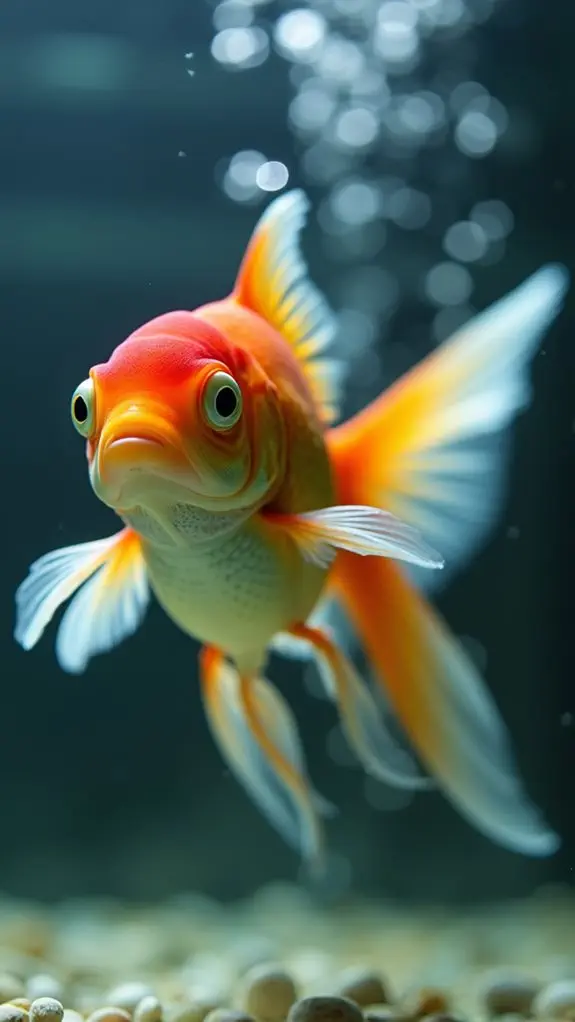
Temperature stress signals in goldfish can be both subtle and obvious, making it vital for you to recognize them early. Your finned friends will show stress indicators through changes in their behavior, appearance, and overall well-being. When they're feeling the heat (or cold), you might notice them swimming frantically around the tank or gasping at the surface for air.
Watch out for changes in your goldfish's normal routine. If they're suddenly refusing their favorite snacks or hiding more than usual, temperature fluctuations might be the culprit. Maintaining stable water temperatures is crucial for preventing infections and diseases in your goldfish, as regular water changes can help maintain optimal water quality. Keep in mind that exceeding 75°F can cause significant stress to your goldfish.
You'll also want to keep an eye on their physical appearance – stressed goldfish often display dull colors, and fancy varieties might develop swim bladder problems. These issues can worsen if your tank is placed near radiators or in direct sunlight.
The sweet spot for goldfish is between 72°F and 75°F, though they can tolerate a wider range. If you notice your fish becoming lethargic or breathing rapidly, check your water temperature immediately.
Tank Location Matters
When you're deciding where to put your goldfish tank, you'll need to carefully weigh indoor versus outdoor placement, as each comes with its own set of temperature challenges.
You'll want to keep your tank away from drafty windows and direct sunlight, which can create unwanted temperature swings that stress your finned friends. Larger tanks help maintain more stable water parameters over time. Fancy goldfish species are particularly vulnerable to these temperature variations. Additionally, the use of a quality filter can greatly assist in keeping the water conditions stable by removing toxins.
The room's overall temperature plays a huge role too – a consistently heated living space might eliminate the need for an aquarium heater, while a chilly basement or sunroom could mean your goldfish will need that extra warmth.
Indoor Vs Outdoor Placement
The location of your goldfish tank plays an essential role in determining whether you'll need a heater. When you're placing your tank indoors, you'll find it's generally easier to maintain a stable temperature since room temperatures typically hover around the ideal range for goldfish. Your tank materials and room placement will help regulate temperatures naturally, rarely dropping below 12°C. Common goldfish species can tolerate these indoor conditions particularly well. Maintaining clean, balanced water is vital for the health of your goldfish, as fluctuations in temperature can stress them and lead to poor water quality.
If you've opted for an outdoor setup, you'll need to be more vigilant about temperature control. Outdoor tanks face challenges from wind, weather changes, and varying sunlight exposure. You'll want to guarantee proper outdoor shade during summer months and consider additional heating solutions during winter. Unlike indoor setups, outdoor tanks usually require heaters and proper insulation to combat environmental fluctuations. Regular monitoring of water parameters is also essential to ensure your goldfish remain healthy.
Whether indoor or outdoor, you'll need to monitor your tank's temperature closely. For indoor setups, a simple thermometer might be sufficient, while outdoor tanks may require a more robust heating system with a reliable thermostat.
Avoiding Drafts and Sunlight
For ideal goldfish health, selecting the right tank location requires careful consideration of both drafts and sunlight exposure. Effective draft management means keeping your aquarium away from windows and doors that open to the outside, as sudden temperature changes can stress your finned friends. Maintaining optimal water quality is essential for preventing stress-related health issues in your goldfish.
You'll want to place the tank in an interior room where the temperature stays consistent and air circulation is minimal. A 20-gallon minimum tank is essential for providing adequate space and maintaining stable water conditions.
When it comes to sunlight control, you'll need to be strategic. While your goldfish might seem to enjoy basking in those warm rays, direct sunlight can quickly turn your tank into a fish sauna – and not the relaxing kind! Instead, opt for indirect lighting or use UV-filtering window treatments if sunlight exposure is unavoidable. You should also keep your tank away from heating vents and air conditioning units, as these can create unwanted temperature fluctuations.
Remember to monitor your tank's temperature regularly with a digital thermometer, aiming to maintain a steady 60-70 degrees Fahrenheit. If you're noticing temperature swings, consider using a heater to keep things stable. Think of it as creating a cozy, draft-free comfort zone for your underwater pals!
Room Temperature Impact
Maintaining stable room temperature plays an essential role in your goldfish's health and happiness. Your little aquatic friend is quite sensitive to temperature fluctuations, so you'll want to be strategic about where you place their tank in your home.
To help your goldfish thrive, consider these key placement factors that affect water temperature:
- Keep the tank away from windows and exterior walls, where drafts can create unwanted temperature swings.
- Avoid placing the aquarium near heating vents, radiators, or air conditioning units.
- Choose a room with consistent temperatures, like a basement or interior room.
- Consider using thermal insulation if you're dealing with a particularly challenging spot.
You'll find that proper tank placement makes a world of difference in maintaining stable conditions for your finned friend.
Think of it like finding the perfect spot for your favorite reading chair – not too hot, not too cold, just right!
If you notice your goldfish becoming less active or showing unusual behavior, check if temperature fluctuations might be the culprit. Additionally, maintaining stable pH levels is crucial as it supports overall aquatic health and prevents stress that can arise from environmental changes.
Choosing the Right Heater
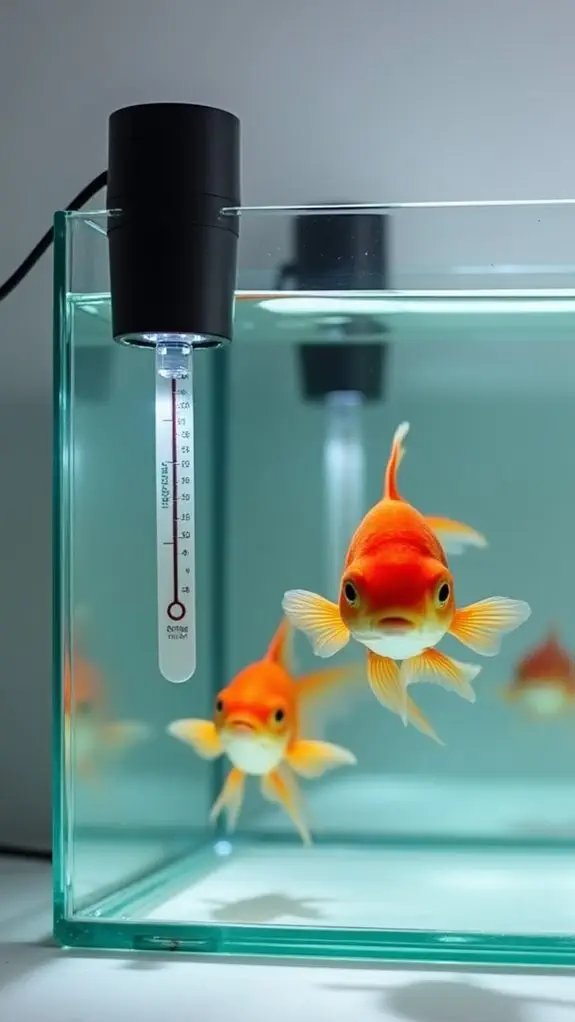
Selecting an appropriate heater for your goldfish tank requires careful consideration of several key factors. When it comes to heater efficiency and safety features, you'll want to focus on high-quality options like the Cobalt Neo-Therm, which offers remarkable temperature stability and reliable performance.
To guarantee your finned friends stay cozy, look for a heater that maintains temperatures between 65-78°F. Here's a pro tip: set your controller two degrees above your target temperature to keep things running smoothly.
Don't forget to grab a separate digital thermometer – it's like having a backup navigator for your tank's climate control!
For added peace of mind, consider using multiple smaller heaters instead of one large one. It's like having a backup plan for your backup plan! Position your heater carefully using the provided suction cups, and always test it before letting it run full-time.
If you're working with a larger tank, you might need additional heating power to maintain consistent temperatures throughout. Regular testing of water parameters will ensure that the heater is maintaining the desired temperature effectively.
Remember to place your tank away from drafty windows and direct sunlight – your goldfish will thank you for creating their perfect temperature-controlled paradise!
Water Quality and Temperature
Temperature stability plays an essential role in your goldfish's health and well-being. Your finned friends thrive in temperatures between 60-70°F, though they're happiest when the water stays between 72-78°F.
Just like you wouldn't want your home's temperature bouncing between extremes, your goldfish needs consistency in their aquatic environment.
While setting up your tank, you'll want to focus on these critical aspects of water quality:
- Proper water filtration to maintain clean, oxygen-rich water
- Regular tank cycling to establish beneficial bacteria
- Consistent temperature monitoring with a digital thermometer
- Adequate aeration, especially in warmer water conditions. Additionally, monitoring nitrate levels is essential to prevent toxin buildup that can affect your goldfish's health.
Summer and Winter Care
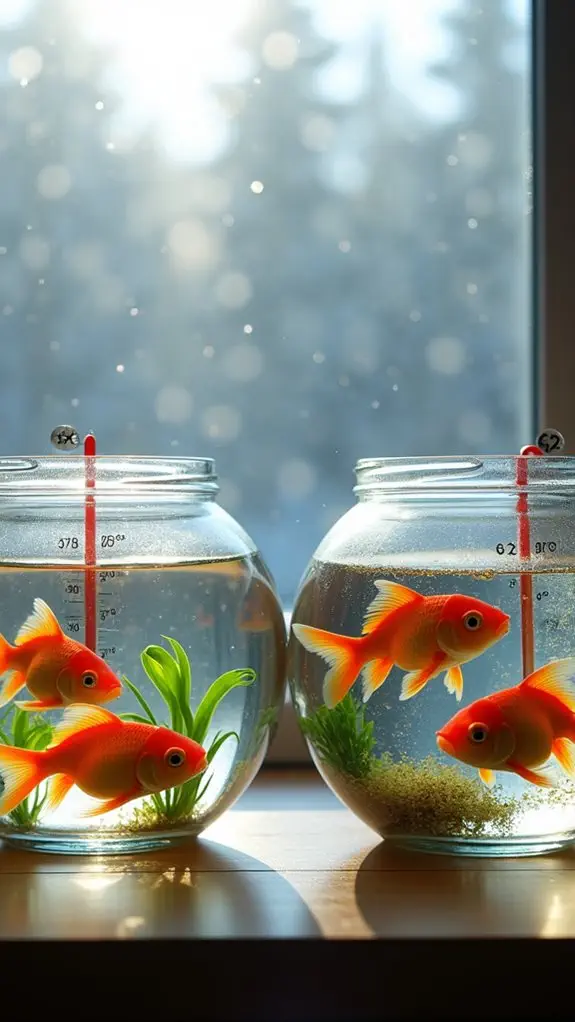
You'll need to adjust your goldfish care routine as seasons change, with summer requiring careful temperature monitoring and winter demanding specific cold-weather protection.
In summer, keep the water temperature below 78°F for fancy goldfish while maintaining proper circulation and oxygen levels. Regular water quality checks can help ensure a stable environment as key water parameters fluctuate with the heat.
During winter, you'll want to protect your fish by preventing complete ice coverage, maintaining an air hole for gas exchange, and stopping feeding when temperatures drop below 50°F.
Seasonal Temperature Management Tips
Proper temperature management throughout the year is essential for your goldfish's health and comfort. When it comes to seasonal adjustments, you'll need to be proactive in maintaining temperature stability for your finned friends.
During summer months, keep your tank between 65-75°F and protect it from direct sunlight that can create unwanted hot spots.
Here are key steps you'll want to follow for year-round temperature management:
- Monitor your tank regularly with a digital thermometer – it's like checking the weather forecast, but for your fish!
- Place your tank away from drafty windows and heating vents to prevent temperature swings.
- Adjust or turn off heaters during summer, but keep them handy for winter months.
- Guarantee proper water circulation to maintain even temperatures throughout the tank.
During winter, you might need to use a heater if your room temperature drops below 60-70°F. Remember to make any temperature changes gradually – your goldfish aren't fans of sudden surprises!
For larger tanks (50+ gallons), you'll find that temperature maintenance is easier since they naturally retain heat better. Just keep in mind that consistent temperatures are key to keeping your goldfish healthy and happy.
Cold Weather Protection Methods
Protection against extreme weather demands careful planning for both summer and winter months. When it comes to cold weather protection methods, you'll need to focus on maintaining proper water conditions and ensuring your goldfish have a safe environment to thrive in.
During winter, you'll want to stop feeding your fish once water temperatures consistently drop below 50°F, as their metabolism slows considerably. It's essential to keep your pond clean and free from debris that could decompose and reduce oxygen levels.
You'll also need to protect your equipment – make sure your pumps and filters can handle cold temperatures without freezing up.
One of the most important cold weather protection steps is maintaining a ventilation hole in the ice. You can use a floating deicer to keep a small area ice-free, but don't break the ice by hitting it – those shock waves aren't exactly what your fish would call a relaxing winter massage!
Keep the pond depth at least 3 feet to prevent complete freezing, and regularly check for signs of fish distress. Remember, your goldfish are counting on you to be their winter weatherproofing expert!
Heater Installation Tips
Installing an aquarium heater requires careful attention to several essential factors. When choosing between different heater types, you'll want to verify you're getting the right size – typically 2.5-5 watts per gallon. For tanks over 50 gallons, don't hesitate to use two smaller heaters instead of one large one, as this helps prevent those pesky cold spots that goldfish aren't too fond of.
Here's what you'll need to focus on for proper heater maintenance and installation:
- Position the heater where water can flow freely around it, keeping it away from decorations and gravel.
- Let the heater acclimate in the tank for a few minutes before turning it on (yes, patience is key!).
- Start with a lower temperature setting and gradually increase it to avoid stressing your finned friends.
- Install a reliable digital thermometer separate from the heater for accurate readings.
Remember to regularly check your heater's performance and keep an eye out for any signs of wear and tear.
It's vital to confirm the heater has proper suction cup adhesion – nobody wants a heater doing the backstroke in their tank!
Always use a heater with an automatic shut-off feature for added peace of mind.
Temperature Monitoring Best Practices
Your goldfish's health and happiness depend heavily on maintaining the right water temperature. When it comes to monitoring your finned friend's environment, you'll want to keep the temperature stable between 68-74°F (20-23.3°C) for most goldfish varieties.
Remember, fancy goldfish prefer things a bit warmer, while common goldfish can handle cooler waters.
To prevent unwanted temperature fluctuations, you'll need to be strategic about your tank's location. Keep it away from windows where direct sunlight could create unexpected warm spots, and guarantee proper tank insulation to maintain consistency.
It's like creating a comfortable home – you wouldn't want your goldfish dealing with sudden hot or cold spells!
Monitor your tank's temperature daily using a reliable digital thermometer. If you need to make adjustments, do it gradually – no more than 1-2°F every 12-24 hours.
Think of it as helping your goldfish adjust to a new thermostat setting! While warmer temperatures can boost metabolism and growth, they might also reduce oxygen levels and increase stress.
Finding that sweet spot is key to keeping your underwater friend thriving.
Frequently Asked Questions
Can Goldfish Survive a Temporary Power Outage Affecting the Heater?
Your goldfish's resilience helps them survive power outages. They'll become dormant in cooler temperatures, using less oxygen. Keep water moving manually and avoid feeding below 54°F to guarantee their survival during the outage.
Should Heaters Be Removed During Medication Treatments?
You shouldn't remove heaters during medication treatments unless specified by the manufacturer. Instead, maintain a stable medication temperature for effective treatment. Just guarantee proper heater safety by monitoring with a reliable digital thermometer.
Do Goldfish Need Heaters When Breeding or Spawning?
You'll want a heater to control breeding conditions and maintain ideal spawning temperature around 20°C. Though some goldfish can breed without heaters, having one guarantees consistent temperatures and better breeding success.
Can Multiple Heaters Be Used in One Tank?
Yes, you can use multiple heaters in one tank. It's recommended for better tank temperature stability and redundancy. Just guarantee proper heater placement on opposite ends to distribute warmth evenly throughout the aquarium.
How Long Do Aquarium Heaters Typically Last Before Needing Replacement?
You'll find your aquarium heater typically lasts 2-5 years, though proper heater maintenance can extend this to 10 years. Different heater types vary in longevity, so regular monitoring and care's essential for peak performance.
Final Thoughts
Whether you need a heater for your goldfish depends on several factors, including your room temperature, tank location, and the specific breed you're keeping. While goldfish are hardy creatures, maintaining stable temperatures between 68-74°F will help them thrive. You'll know you've got it right when your finned friends are active and eating well. Remember, it's better to invest in proper heating now than deal with stressed, unhealthy fish later.

